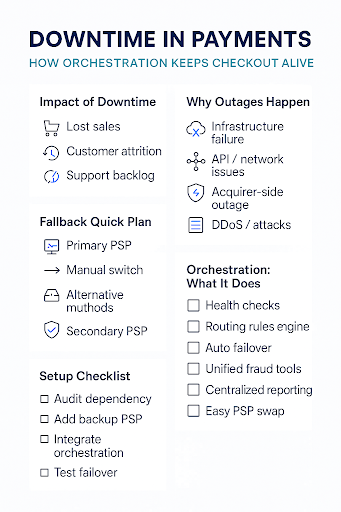
October 10, 2025
Downtime in payments: how payment orchestration eliminates PSP outage risk
- The cost of PSP outages
- Common causes of downtime in payments
- What to do when a PSP goes down
- Routing logic and fallback design
- Static vs dynamic fallback
- How payment orchestration mitigates PSP downtime
- Best practices for deploying orchestration against downtime
- Compliance and operational factors
- A strategic roadmap for reducing downtime risk
- FAQ
Payment downtime stops revenue instantly. When a payment service provider (PSP) goes down, there is nothing merchants can do except wait until it comes back online. Shoppers abandon carts, support teams handle complaints, and every minute of silence costs money. Without a fallback connection, even short outages can turn into hours of lost sales.
PSP downtime is not rare. High transaction peaks, system upgrades, and unexpected technical issues can disrupt card authorization and wallet payments. Merchants relying on a single PSP have no safety net when that provider goes offline.
Payment orchestration changes this. By connecting multiple PSPs under one control layer, merchants can reroute transactions instantly and keep sales moving when one provider fails. This article explains why downtime in payments matters, what causes PSP outages, and how orchestration offers reliable fallback options to protect revenue.
The cost of PSP outages
Payment downtime is expensive in two ways.
Direct loss of sales
If a PSP outage hits during peak traffic — a flash sale or seasonal rush — customers cannot pay. Many abandon checkout instead of retrying later. The lost revenue is immediate.
Brand and support impact
Shoppers remember failed checkouts. Trust suffers, reviews reflect frustration, and support costs rise as teams manage complaints and refunds. For subscription businesses, failed initial charges mean churn before the customer even starts using the product.
Studies show downtime can cost large retailers hundreds of thousands of dollars per hour. Even mid-sized merchants lose thousands during a single PSP outage. Real uptime depends not just on a provider’s SLA but on having fallback routes ready.
For background on global payment system reliability and how merchants design modern stacks, see Why payment orchestration matters for European merchants expanding cross-border. While written for Europe, its principles apply globally.
Common causes of downtime in payments
PSP outages happen for many reasons:
- Infrastructure failure: Data center or cloud issues cause API timeouts and declines.
- Network and API disruptions: Integration endpoints go offline or respond too slowly.
- Bank or acquirer outages: The PSP may depend on a bank network that fails.
- Maintenance and upgrades: Scheduled work sometimes causes unexpected downtime.
- Traffic surges or DDoS attacks: High demand can overload payment systems.
No provider is immune. Even PSPs promising 99.99% uptime experience incidents. Merchants should plan for failure as a certainty, not a possibility.
What to do when a PSP goes down
Merchants facing PSP downtime have several options, each with trade-offs:
Manual switching
Some teams keep backup PSP credentials and can reroute traffic manually. This avoids complete shutdown but is slow and error-prone, especially under pressure.
Redirect to alternative payment methods.
Offering digital wallets or local APMs can keep some sales alive during a PSP outage. But this only helps if customers adopt those methods, and checkout UX supports quick switching.
Queue transactions
Holding payments until service returns protects orders but delays fulfillment and creates customer frustration.
Automated failover
The most reliable strategy is automated failover; traffic moves to another PSP instantly when the primary fails. But building this logic in-house is complex and expensive.
For guidance on supporting more payment types globally, see How to accept alternative payment methods. Broad method coverage strengthens resilience when a single rail goes down.
Routing logic and fallback design
Fallback success depends on how routing is set up. Merchants can choose between static and dynamic approaches.
- Static fallback: Define a backup PSP that only activates when the primary fails.
- Dynamic routing: Evaluate performance in real time, switching traffic based on latency, approval rates, and cost.
Dynamic systems also allow cascading: if one PSP fails, traffic flows to the next available route automatically.
Static vs dynamic fallback
| Feature | Static fallback | Dynamic routing & failover |
| Setup effort | Simple | Higher, but scalable |
| Reaction speed | Manual or delayed | Real time |
| Optimization | Limited | Uses performance data |
| Coverage | One backup PSP | Multiple PSPs with cascading paths |
| Best for | Small setups with one backup | Merchants needing global resilience |
Merchants serious about protecting revenue invest in dynamic routing. The challenge is complexity, maintaining API connections, monitoring PSP health, and reacting in milliseconds. This is where orchestration becomes essential.
How payment orchestration mitigates PSP downtime
Many merchants still rely on legacy payment systems that make every new PSP integration slow and expensive. Each connection requires development work, compliance checks, and ongoing maintenance. This complexity often discourages businesses from diversifying their payment stack, leaving them exposed when one provider fails.
Payment orchestration eliminates this limitation by acting as a single control layer over multiple PSPs. Instead of rebuilding integrations one by one, merchants connect once to an orchestration platform that manages routing, tokenization, and reporting across all providers. This setup removes the dependency on legacy infrastructure and allows real-time switching if a PSP goes offline.
Single connection, multiple PSPs
Instead of integrating with each PSP separately, merchants connect once to an orchestration platform. Adding or swapping PSPs later takes configuration, not new development. With Gr4vy, the effort of building and maintaining new PSP connections is reduced by up to 80% compared to in-house development. This agility makes it easier to expand into new markets and ensures checkout stays live if one provider goes offline.
Real-time health checks and automatic failover
An orchestration layer monitors PSP uptime and latency. If a provider slows down or stops responding, the system automatically shifts transactions to an active route. Customers continue to see a smooth checkout rather than an error screen. Merchants can also define custom routing rules to prioritize the least-cost provider, balance traffic by region, or apply business logic to specific payment methods. This turns failover into a strategic advantage, not just a backup plan.
Unified routing engine
Merchants can define rules by card type, issuer country, cost, or historical approval rates. When the primary PSP fails, these rules control where traffic goes next. For example, Visa debit from a certain BIN range can route to the PSP with the highest approval rate for that card.
Consistent fraud and security
Without orchestration, each PSP runs its own fraud checks. During a failover, merchants risk inconsistent screening. An orchestration platform applies one fraud policy across all PSPs so risk controls remain steady even during outages. For more on unified fraud management, see Fraud prevention for ecommerce: best practices for merchants.
Clear reporting and reconciliation
Switching PSPs mid-transaction can make finance teams work harder. Orchestration centralizes transaction logs, approval metrics, and settlement data, so payment operations stay clear even when traffic moves between providers.

Best practices for deploying orchestration against downtime
A strong orchestration strategy is not just about adding a second PSP. It requires planning and testing.
Start with risk mapping
Audit each market and payment method. Identify where you depend on a single PSP or acquirer and where outages would have the biggest revenue impact.
Add redundancy gradually
Start with two PSPs in one high-volume market. Configure fallback rules and monitor results. Expanding step by step reduces complexity and avoids major rollout issues.
Monitor health and decline codes
Track error rates and network latency in real time. Knowing the difference between a technical failure and a card issuer decline helps you route correctly. Merchants that analyze decline codes can choose the best fallback logic for each failure type.
Keep compliance central
When adding PSPs, card data exposure increases. Use orchestration with a secure vault to stay PCI DSS compliant and reduce audit scope. This also supports regulations such as GDPR for European customers and other privacy laws worldwide.
For merchants exploring global expansion and risk management, see Why payment orchestration matters for European merchants expanding cross-border. The same principles apply when building resilient fallback strategies.
Compliance and operational factors
Outage planning is not only technical; it is also regulatory and operational.
- PCI DSS: Storing or transmitting cardholder data requires strict controls. An orchestration platform with a PCI-compliant vault reduces your scope.
- Regional data rules: Europe, Brazil, and parts of Asia restrict where payment data can be stored. Orchestration platforms often support data localization to meet these laws.
- Strong Customer Authentication (SCA): In Europe, rerouting a transaction during downtime must still comply with PSD2 Strong Customer Authentication (SCA) requirements. Merchants need orchestration that can reinitiate authentication or apply exemptions when switching PSPs. For example, if a transaction through Carte Bancaire in France fails because the PSP goes offline, the orchestration platform can automatically reprocess it through another provider while maintaining full SCA compliance.
- Fraud continuity: Fallback routes should keep the same risk controls to avoid opening gaps during outages.
Operationally, payment, engineering, and finance teams need shared visibility. Dashboards, alerts, and reporting from orchestration reduce silos and help teams respond quickly when a PSP goes offline.
A strategic roadmap for reducing downtime risk
Merchants that want to prepare for PSP outages can follow a staged approach:
- Audit current PSP dependencies: List providers, their uptime history, and approval rates per market. Identify single points of failure and high-volume regions.
- Evaluate fallback needs: Decide which regions or payment types need redundancy first. Look at peak sales periods and high-value markets.
- Integrate payment orchestration: Replace manual routing with an orchestration platform. This step simplifies adding more PSPs and centralizes fraud and reporting.
- Build dynamic routing and health monitoring: Use real-time health checks and approval data to send traffic intelligently. Set cascading fallback rules for primary, secondary, and tertiary routes.
- Test failover regularly: Simulate PSP outages in a controlled way to verify fallback logic and keep teams prepared.
- Expand and optimize: Once failover works in one region, roll it out globally. Add local PSPs where they outperform global ones. Monitor cost and success rates continuously.
For merchants planning global expansion while staying resilient, see Card acquiring for international markets and Top 10 benefits of using payment orchestration. Both provide insight into building multi-provider strategies that balance uptime, cost, and compliance.
FAQ
Can orchestration guarantee zero downtime?
No system can promise absolute uptime, but orchestration removes single-point PSP failure and limits service disruption. Gr4vy goes further by using a single-instance cloud deployment model, which isolates each merchant’s environment. Unlike multi-tenant POPs that share infrastructure, this approach ensures that downtime in one environment never affects another. Combined with real-time failover between PSPs, it provides the highest possible availability and visibility into every transaction.
Will fallback logic slow down checkout?
Not when well configured. Health checks and routing decisions run in milliseconds. Customers typically experience no delay during PSP failover.
Is adding multiple PSPs worth the extra cost?
Yes, for most merchants processing significant volume. Resilience and higher approval rates often outweigh the added platform and contract costs.
How much work is required to add backup PSPs through orchestration?
Far less than direct integrations. Once connected to an orchestration platform, adding or replacing PSPs is mostly configuration, not custom code.
Downtime in payments costs more than lost transactions. It damages customer trust, increases support workload, and disrupts revenue during critical sales moments. PSP outages are unavoidable, but merchants do not need to be unprepared.
Payment orchestration creates the resilience modern commerce demands. It centralizes multiple PSPs, automates failover, maintains fraud consistency, and gives real-time control over routing. With orchestration, merchants can survive provider outages, keep checkout online, and focus on growth rather than firefighting.
Contact Gr4vy to design a payment stack that stays live when PSPs fail and protects revenue across every market.